Brian Solis's Blog, page 7
April 19, 2025
The Rise of Synthetic Intimacy: AI is Becoming Your Co-Pilot in Real Life

How do you use generative AI?
Is it to create content, collaborate on work, ideate, learn, code, or seek direction?
What if I told you that, according to one research study, the number one application for generative AI is to help with mental health and loneliness?
According to one study, people are increasingly turning to AI for emotional support, personal growth, and self-improvement.
This is the 2nd year in a row when Marc Zao-Sanders publishes his research in Harvard Business Review, that explores “How People are Really Using Gen AI.”
As a digital anthropologist, it’s fascinating. As a digital analyst, I have many questions, especially around the subjective methodology and scope. I wouldn’t view these results as scientific nor do I agree with their accuracy. But let’s set that aside for now and have fun with the findings at a human level.
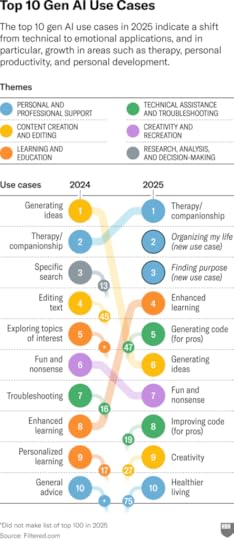
According to this research effort, we see top use cases shifting from curiosity, collaboration, and productivity to something more personal and growth oriented, with the top three including therapy/companionship, organizing my life, and finding purpose. The latter two represent new uses in 2025.
The number one use case is both surprising and not surprising, “therapy/companionship.” It’s surprising to see humans use artificial intelligence to virtualize treatment and healing. It’s not surprising though that people find it more approachable to embrace synthetic intimacy. Years ago, for example, I studied the willingness of men to open-up to AI for therapy and adults in general to seek medical advice from AI. In both cases, the sentiment was similar. It was not only easier to speak candidly and openly to a machine, it was cathartic and beneficial. People could be honest with AI versus another human being, without the fear of being judged.
The same could be true for organizing my life and finding purpose. When people recognize the opportunity to change or improve, it’s easy to put it off or ultimately deny that anything urgent or ultimately needed at all. But with AI, people can express themselves freely, from the comfort of anywhere, to receive nonjudgmental advice and insights.
To see enhanced learning jump from number 8 in 2024 to number 4 in 2025 is also testament to people recognizing AI as a companion for self-improvement and personal and professional development. And with creativity jumping from number 27 to number 9 and healthier living climbing from 75 to 10, 80% of the top 10 gen AI use cases are aimed at personal and professional development (I’m aggregating four classifications as they reflect behavior that would overlap on a VENN diagram instead of representing four separate behaviors/intentions/aspirations. For example, Creativity is categorized as “content creation and editing” and “fun and nonsense” is classified as “creativity and recreation.”
A New Chapter in Human + Machine AugmentationIn these high-level findings, several profound patterns emerge, with each pointing to a fundamental Mindshift in how humans and machines are co‑evolving (A mindshift = fundamentally changing how we perceive and interact with the world and how we take different actions as a result. Embracing new perspectives enables us to adapt, innovate, and lead effectively in times of change!)

We are witnessing a Mindshift in how people interact with AI.
The diverse applications of generative AI across both personal and professional domains illustrate how individuals are integrating this technology into their daily lives. This aligns with what I call the “Novel Economy,” where traditional rules no longer apply, and new opportunities emerge that require innovative thinking and adaptability .
In my research, I documented the emergence of “Generation Novel” (Gen N), a cross-generational cohort shaped by disruptive technologies, digital experiences, and global events. The widespread adoption of generative AI tools, as highlighted in the article, exemplifies how Gen N is leveraging technology to redefine work, creativity, and personal growth.
This initial research provides evidence of a broader cultural transformation, where technology serves as a catalyst for reimagining human potential and societal norms. This is a time for a Mindshift, one where open-mindedness, curiosity, and creativity fuel the continued exploration of how AI can be harnessed, where it works for us, not the other way around, to foster creativity, enhance productivity, and drive meaningful change.
Continue reading…
Mindshift: Transform Leadership, Drive Innovation, Reshape the Future
Lifescale: How to Live a More Creative,Productive, and Happy Life
The post The Rise of Synthetic Intimacy: AI is Becoming Your Co-Pilot in Real Life appeared first on Brian Solis.
April 13, 2025
Thinkers360 Interviews Brian Solis About Mindshift, Leadership, Innovation, and the Future
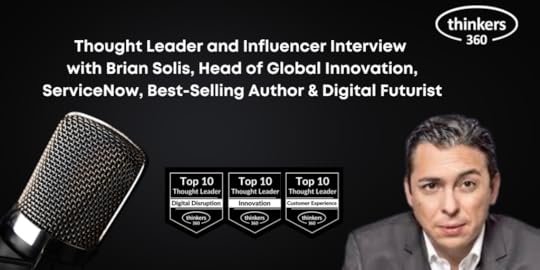
via Thinkers360
Thought Leader and Influencer InterviewThinkers360 thought leader interviews profile prominent members of the Thinkers360 community who embody the power of ideas in their work. In this edition, we speak with Brian Solis, head of global Innovation, ServiceNow.
Brian is an eight-time, best-selling, and award-winning author and has published more than 60 research reports on the future of business, work, digital transformation and innovation across industries such as retail, healthcare, financial services, insurance, and public sector.
His blog, BrianSolis.com, is among the world’s leading business online resources to his 800,000 followers. Brian also contributes to Fast Company, ZDNet, Forbes, Worth, CIO, and Singularity University.
In his new book Mindshift: Transform Leadership, Drive Innovation, and Reshape the Future, you’ll discover why legacy leadership continues to miss the mark and fail to adequately account for change and innovation, causing people to miss the winds of opportunity or threats of disruption until it’s too late. His research-backed tools, insights and lessons show how anyone can become an unstoppable leader, in both business and life.
Brian is featured in Thinkers360’s annual leaderboards: Top 50 Global Thought Leaders and Influencers on Metaverse 2024, Top 50 Global Thought Leaders and Influencers on Digital Disruption 2024, and Top 50 Global Thought Leaders and Influencers on Future of Work 2024 among others.
In this thought leader and influencer interview, we asked Brian specifically about his new book “Mindshift” (see press release) which was just published on October 15th 2024.
Thinkers360: How would you define a “mindshift”?
BDS: A mindshift is the process of fundamentally changing how we see the world and ourselves in it. It’s about breaking free from old patterns of thinking and embracing new perspectives that enable us to adapt, innovate, and lead in times of disruption. A mindshift allows us to reframe challenges as opportunities and empowers us to envision a future that doesn’t yet exist, but that we have the power to create.
Thinkers360: Can you tell us more about your background and why you are considered one of the greatest digital analysts of our time?
BDS: I’ve spent my career studying the impact of emerging technologies on businesses and society. As a digital analyst and anthropologist, I’ve had the opportunity to work with some of the world’s most influential companies and thought leaders. My work involves not just analyzing trends but understanding the deeper shifts in human behavior and how technology can be a catalyst for positive change. My goal has always been to help people and organizations understand these changes and harness them to create meaningful, lasting impact.
Thinkers360: With disruption comes difficulty. In what ways is someone’s mindset the most important part of the equation of success?
BDS: Our mindset is the lens through which we interpret and react to the world around us. In times of disruption, a growth-oriented mindset can turn obstacles into steppingstones. When we view challenges as opportunities for growth, we’re more resilient, adaptable, and innovative. It’s not the disruption itself but how we respond to it that determines our success. A mindshift equips us with the mental agility to see beyond the immediate difficulty and envision new possibilities.
Thinkers360: You coined the term, “Novel Economy.” What is it and why is it important?
BDS: The “Novel Economy” refers to the new landscape shaped by unprecedented technological, social, and economic changes. It’s an era where the old rules no longer apply, and new opportunities are emerging that require a fresh mindset. This economy values innovation, adaptability, and the ability to think beyond traditional models. It’s important because it demands that we continually evolve our thinking, be open to new ideas, and actively participate in shaping the future.
Editor’s Note: See Brian Solis´s profile to work with him directly.
Thinkers360: What is a “Ctrl+Alt+Delete opportunity” and how can we use it for our benefit?
BDS: A “Ctrl+Alt+Delete opportunity” is a chance to hit the reset button on our lives, careers, or organizations. It’s about recognizing moments when we need to reboot our thinking, let go of outdated practices, and start anew. By seizing these opportunities, we can reimagine our paths, innovate, and create something better. It requires courage and the willingness to question the status quo, but it opens the door to growth and transformation.
Thinkers360: You state that every mindshift begins with a spark of curiosity. Why is curiosity essential to shifting our mindset?
BDS: Curiosity is the fuel for learning and discovery. It pushes us to explore the unknown, ask questions, and challenge what we think we know. When we’re curious, we’re more open to new ideas and perspectives, which is crucial for making a mindshift. Curiosity allows us to see beyond our current limitations and imagine what’s possible, setting the stage for innovation and growth.
Thinkers360: You describe yourself as a “digital anthropologist.” How has your mindset impacted the trajectory of your career?
BDS: As a digital anthropologist, my focus has always been on understanding how technology impacts human behavior and culture. This mindset has driven me to look beyond the surface of technological trends and delve into the underlying shifts in how we live, work, and connect. It’s about recognizing patterns and understanding the ‘why’ behind the changes we see. This perspective has guided my work in helping organizations navigate digital transformation in a way that is human-centric and future-focused.
Thinkers360: Who is a modern figure that you would call a “mindshifter” and why?
BDS: One example is Satya Nadella (CEO of Microsoft). Nadella transformed Microsoft by fostering a growth mindset throughout the company. He shifted the culture from a fixed mindset focused on competition to one that emphasizes learning, innovation, and collaboration. Under his leadership, Microsoft embraced cloud computing, AI, and open-source software, reinvigorating the company’s relevance in the tech industry.
Thinkers360: You define a “change agent” as being a believer in and catalyst of progress. After researching change agents, what did you learn about them?
BDS: Change agents are individuals who see the world not just as it is, but as it could be. They are driven by a deep belief in the possibility of progress and are willing to take risks to make it happen. What I learned is that change agents come from all walks of life and organizational levels. They share a common trait: the courage to challenge the status quo and the determination to turn vision into reality. They are not deterred by obstacles; instead, they see them as opportunities to innovate.
Change agents are also not fearless; they often feel uncertainty and doubt, questioning if they have the strength or courage to drive change. This vulnerability is a part of the journey. What sets them apart is their willingness to act despite these feelings. They understand that making an impact requires having hard conversations and taking challenging actions.
Being a change agent means embracing discomfort, knowing that growth and transformation lie on the other side. It’s not about having all the answers; it’s about committing to the process of learning and evolving.
Every great change starts with a small, courageous step. Even if you don’t feel ready, your unique perspective and willingness to challenge the status quo are exactly what the world needs. Remember, it’s in those moments of uncertainty that true leaders are born.
Thinkers360: You’ve helped executives at companies like Uber, Airbnb, Walmart, and Coca-Cola in addition to celebrities such as Oprah, Shaq, and Ashton Kutcher make a mindshift towards emerging technology and society. What has collaborating with these companies and people taught you?
BDS: Working with such a diverse range of companies and individuals has taught me that the common thread in achieving a mindshift is willingness, like feeling the need because there is no other option, to embrace discomfort and uncertainty. For example, helping a startup like Uber challenged me to think beyond traditional business models and embrace the idea of disruptive innovation. Travis Kalanick always believed in the fight for the “truth.”
With Coca-Cola, the focus was on reimagining customer engagement in a digital age. Through these experiences, I learned that every organization, regardless of size, must be willing to rethink its approach to adapt to changing environments.
Collaborating with figures like Oprah and Ashton Kutcher has shown me that even those in the public eye must navigate their own mindshifts to stay relevant. Oprah, for instance, has continually evolved her media presence, showing the power of adapting to new platforms and technologies. Shaq and Ashton have leveraged their influence to back emerging technologies and startups, demonstrating how embracing change can lead to impactful investments.
These experiences reinforced the importance of a growth mindset and the courage to experiment, learn, and pivot. It’s not just about adopting new technologies but about transforming how we think about our roles in the world and the value we can create.
Thinkers360: How does this book apply to AI and other trends on the horizon like ambient and spatial computing?
BDS: Mindshift provides a framework for how to approach and adapt to rapidly evolving technologies like AI, ambient, and spatial computing. These trends are reshaping how we interact with the world and each other. By adopting a mindshift, we become more open to exploring these technologies’ potential, understanding their impact, and leveraging them to create positive change. The book encourages us to view these advancements not just as tools, but as opportunities to reimagine the future.
Thinkers360: How is this different from other leadership and management books?
BDS: Mindshift delves into the fundamental personal change in thinking required to lead in today’s world. It’s not just about managing people or processes; it’s about transforming how we see the world, ourselves, and our role in shaping the future. It’s a call to action for leaders to embrace a new mindset that is adaptable, curious, and innovative. It’s about leading with a vision that inspires others to join in creating a better tomorrow.
Thinkers360: What are the first steps anyone can take to jumpstart their mindshifting journey?
BDS: The first step is to embrace curiosity. Start asking questions and challenge your current way of thinking. Reflect on the assumptions you hold and be willing to see things from a different perspective. Next, step out of your comfort zone and seek new experiences that broaden your understanding of the world. Engage with people from diverse backgrounds, explore new technologies, and be open to learning. Remember, a mindshift begins with the willingness to change and the courage to take the first step.
The post Thinkers360 Interviews Brian Solis About Mindshift, Leadership, Innovation, and the Future appeared first on Brian Solis.
March 29, 2025
Fundscene – Trend 6: Technologischer Wandel und Digitalisierung

via FundScene
Wachstumsstrategien im Zeitalter der Technologie
Zusammenfassung:
In der heutigen schnelllebigen digitalen Ära ist die technologische Transformation nicht mehr nur ein Vorteil – sie ist eine Notwendigkeit. Unternehmen aller Branchen überarbeiten ihre Betriebsmodelle, um in diesem technologiegetriebenen Zeitalter nicht nur zu überleben, sondern erfolgreich zu sein. Dieser Artikel beleuchtet die treibenden Kräfte hinter der digitalen Transformation, die Technologien, die Branchen verändern, und zeigt, wie innovationsgetriebene Unternehmen ihre Wettbewerber übertreffen. Fachmeinungen, konkrete Daten und reale Fallstudien machen deutlich, warum Unternehmen jetzt handeln müssen, um ihre Zukunft abzusichern.
Die Welle der digitalen Transformation
Digitale Transformation bedeutet heute weit mehr als nur ein Software-Upgrade oder den Launch einer Website – sie steht für eine vollständige Neuausrichtung von Geschäftsprozessen, Wettbewerbsstrategien und Kundennutzen.
Im Kern ersetzt die Digitalisierung traditionelle Abläufe durch automatisierte Workflows, Echtzeit-Datenzugriffe und intelligente Systeme. Dieser Wandel ermöglicht es Unternehmen, agiler, widerstandsfähiger und datengetriebener zu werden.
Laut McKinsey & Company (2024) haben 70 % der Unternehmen weltweit ihre Digitalisierungsbemühungen beschleunigt – Technologie ist längst das Rückgrat moderner Geschäftsstrategien. Es geht nicht mehr um das ob, sondern nur noch um das wie schnell.
Personen im Fokus – Die führenden Köpfe der digitalen Transformation
Hier sind zehn Expertinnen und Experten, die den digitalen Wandel maßgeblich mitgestalten – ein Blick auf ihre LinkedIn-Profile lohnt sich für alle, die am Puls der Innovation bleiben wollen:
Die technologische Transformation ist die zentrale Herausforderung – und zugleich die größte Chance – des Jahres 2025.
Um erfolgreich zu sein, müssen Unternehmen über die bloße Einführung einzelner Technologien hinausgehen. Stattdessen gilt es, eine digital-first-Kultur zu etablieren, Mitarbeitende mit zukunftsfähigen Kompetenzen auszustatten und kontinuierliche Innovation fest in der Unternehmens-DNA zu verankern.
In einer Welt, in der Wandel zur Konstante geworden ist, wird Anpassungsfähigkeit zum entscheidenden Wettbewerbsvorteil.
The post Fundscene – Trend 6: Technologischer Wandel und Digitalisierung appeared first on Brian Solis.
March 19, 2025
Harvard Business Review: Train Your Brain to Work Creatively with Gen AI by Brian Solis

Illustration by Brian Rea
Harvard Business Review featured a highly popular article by Brian Solis, “Train Your Brain to Work Creatively with Gen AI.”
Summary: When most people prompt generative AI, they do so within the paradigm of how they think about what could or should come next. For example, when searching Google, users may ask a question, search for the best Thai restaurant “near me,” or insert specific criteria based on filtered output, such as “best downhill mountain bike for intermediate riders.” That approach is often carried into prompting. The results build on a linear path of thinking, research, and decision-making based upon the world as we know it. However, where AI starts to “come alive” is when you create something unique — something that wouldn’t have been achieved without a human and machine collaboration. This requires challenging your own conventions around how you think GenAI should work, and also the outcomes you think are expected or possible. This article offers 12 exercises to help you expand the way you think about prompting GenAI. Leaders who foster these mindshifts within their teams will find themselves cultivating a culture where “the impossible” becomes a daily challenge — and achievement.
Excerpt:
There are countless articles on how to use generative AI (gen AI) to improve work, automate repetitive tasks, summarize meetings and customer engagements, and synthesize information. There are also scores of virtual libraries brimming with prompting guides to help us achieve more effective and even fantastical output using gen AI tools. Many common digital tools already feature integrated AI co-pilots to automagically enhance and complete writing, coding, designing, creating, and whatever it is you’re working on. But there is so much more to generative AI beyond enhancing or accelerating what we already do. With the right mindset shift, or mindshift, we can train our brains to creatively rethink how we use these tools to unlock entirely new value and achieve exponential outcomes in what’s becoming an AI-first world.
When most people prompt, they do so within the paradigm of how they think about what could or should come next. For example, when searching Google, users may ask a question, search for the best Thai restaurant “near me,” or insert specific criteria based on filtered output, such as “best downhill mountain bike for intermediate riders.” That approach is often carried into prompting. The results build on a linear path of thinking, research, and decision-making based upon the world as we know it. This is perfectly normal and effective. In fact, it’s how today’s generative AI models largely work.
Generative AI relies on natural language processing (NLP) to understand the request and generate relevant results. It’s basically pattern recognition and pattern assembly based on instructions to deliver output that completes the task at hand. This approach aligns with our brains’ default mode: pattern recognition and efficiency-seeking, which favors short, straightforward prompts to get immediate, predictable results.
If most people use gen AI in this way, then no matter how powerful the tools, we inadvertently create a new status quo in how we work and create. Training our brains to challenge our thinking, our assumptions of AI capabilities, and our expectations for predictable results starts with a mindshift, to recognize AI not as just a tool, but as a partner in innovation and exploring the unfamiliar.
Click here to read the full article at HBR.
The post Harvard Business Review: Train Your Brain to Work Creatively with Gen AI by Brian Solis appeared first on Brian Solis.
March 18, 2025
Harvard Business Review Italia: Innovare con l’IA: una sfida all’approccio “business as usual”

HBR Italy published an insightful article by Brian Solis that explores the imperative for AI Business Transformation.
È giunta l’ora di sfruttare l’intelligenza artificiale per lanciare l’azienda verso nuovi orizzonti e la dicotomia tra continuità e cambiamento ne detterà il passo e la direzione.
Quale sarà il ruolo dell’IA e dell’IA generativa nelle aziende? Come adottarle in modo sicuro ed etico? Cosa significa time-to-value? Queste le domande che si pongono i dirigenti. D’altro canto, però, non si chiedono come l’IA stia trasformando i mercati, le aspettative e i comportamenti di clienti e dipendenti, e come questi influenzino i modelli operativi e di business. Non ponendosi questi quesiti, i dirigenti si basano sulle esperienze pregresse per ideare strategie e prendere decisioni, prendendo i processi e i sistemi esistenti come riferimento per l’automazione e l’eliminazione dei costi; in questo modo si crea una cultura basata sulla continuità, in un’epoca in cui l’IA impone la necessità di un cambiamento. La dicotomia tra continuità e cambiamento detterà il passo e la direzione, in meglio o in peggio, della competitività tra le aziende di oggi e quelle di domani, nate con l’IA.
Nel lavoro intitolato Le sfide di management del XXI secolo, Peter Drucker ha rilevato che, essendo state progettate nell’ottica della continuità, le istituzioni tradizionali risultano refrattarie al cambiamento. Funzionano quindi in modo adeguato solo se l’ambiente in cui operano è prevedibile, comprensibile o noto. L’IA, invece, sfida l’approccio “business as usual”, introducendo nell’equazione fattori quali incertezza e possibilità.
I dirigenti non sono consapevoli di ciò che non conoscono. I leader tradizionalisti cercheranno di sfruttare l’IA quale strumento abilitante della continuità moderna. Per converso, i promotori del cambiamento faranno in modo di inserire l’IA e le rispettive incognite in una struttura che faccia di curiosità, sperimentazione e innovazione elementi del proprio modello di continuità.
In un contesto in cui un’organizzazione su due segue lo stesso copione, è giunto il momento di sbarazzarsi del vecchio e scriverne uno nuovo. Per progredire, i leader devono porsi domande diverse e mettere in dubbio gli assunti di base relativi ai modelli operativi e di business convenzionali e alle modalità di interazione tra i medesimi.
Dal futuro del lavoro ai flussi che lo definiscono, l’unico limite al ruolo svolto dall’IA nell’ambito dell’automazione e del potenziamento di un’attività è proprio la capacità di reimmaginare il lavoro stesso. Se si vuole garantire un futuro alla propria organizzazione e generare nuovo valore commerciale netto, bisogna ricorrere all’IA non solo per migliorare e ottimizzare le attività esistenti, ma anche per innovare ed eseguire quelle attività che prima del suo avvento non era possibile svolgere.
In sostanza, è giunta l’ora di sfruttare l’IA per lanciare la propria azienda verso nuovi orizzonti, iniziando dal comprendere come la stessa stia già modificando le modalità con cui viene portato a termine un lavoro.
Da automazione intelligente a innovazione intelligente
La reazione più comune all’IA è inserirla nelle modalità operative già esistenti. Iniziative quali l’eliminazione dei costi, l’automazione fine a sé stessa e i tagli ai posti di lavoro sono emblematiche di imprese che hanno impiegato l’IA senza considerarne il pieno potenziale. Mi riferisco a questo approccio con il termine “iterazione”, cioè automatizzare i processi esistenti per ottimizzare il lavoro, ridimensionare, ridurre i costi, eliminare le fasi inutili e dare slancio alle prestazioni.
L’iterazione è indispensabile. Tuttavia, se diventa l’unico approccio nell’uso dell’IA, si attribuisce troppa enfasi all’efficienza, perdendo la visione strategica di più ampio respiro o il potenziale dell’IA stessa.
Prendersi tempo per valutare il potenziale trasformativo dell’IA può consentire ai capi d’azienda di cogliere anche le opportunità di innovazione, per esempio potenziare i processi esistenti con potenzialità innovative per creare nuovo valore.
Il punto di inizio? L’individuazione dei “job to be done”
Negli anni ’40, Leo McGivena fece un’osservazione che divenne successivamente molto popolare: “Ai consumatori non interessa acquistare un trapano da un quarto di pollice. Vogliono fare un foro da un quarto di pollice!”. La realizzazione di un foro da un quarto di pollice è il “job to be done”, ossia il lavoro da svolgere. La progettazione del trapano e della rispettiva punta e una maggiore efficacia di processo rappresentano invece l’opportunità di innovazione.
Il “job” è, in pratica, ciò che un soggetto (cliente o dipendente) cerca di realizzare. Rappresenta la necessità fondamentale o la problematica che spinge un soggetto a ricercare una soluzione. Riprendendo la metafora della punta da trapano, non basta produrne in modo più efficiente. L’IA, infatti, non consente soltanto di automatizzare il processo di trapanatura, ma anche di realizzare un flusso di lavoro più efficace, aprire nuovi mercati per il trapano e addirittura creare nuove opportunità commerciali che nascono all’interno del processo di progettazione, produzione e vendita nel suo complesso.
Clayton Christensen una volta dichiarò che “comprendere veramente le esigenze dei clienti [o dipendenti] … significa comprendere il processo sottostante e … aiutarli a realizzare ciò che stanno già cercando di fare”. Allo stesso modo, il punto di partenza dell’innovazione è comprendere l’effetto dell’IA sui “job to be done” di clienti e dipendenti. L’IA non è solo in grado di migliorare molti “job to be done”, ma consente anche di reimmaginarli sulla base dell’uso che clienti e dipendenti fanno già dell’IA per risultare più efficaci.
Oltre l’efficienza per puntare all’efficacia
L’IA ci mette nella condizione di ripensare il modo in cui facciamo le cose, concentrandoci sugli obiettivi finali e ricercando il percorso migliore per conseguirli. Peter Drucker ha semplificato il concetto sostenendo che “efficacia significa fare le cose giuste, mentre efficienza significa fare le cose nel modo giusto”. Per essere al contempo efficienti ed efficaci occorre comprendere i “job to be done”. Solo in questo modo possiamo sfruttare l’intelligenza artificiale per 1) automatizzare processi e flussi di lavoro efficaci nell’ottica di una maggiore efficienza e 2) collaborare con altri soggetti per reimmaginare i processi e i flussi di lavoro esistenti nell’ottica di una maggiore efficacia e innovazione.
Un approccio innovativo per il futuro
In un’epoca in cui le aziende sentono la pressante necessità di fare di più con meno, risulta sempre più chiaro che la strada verso progresso e innovazione non può essere caratterizzata soltanto da automazione e tagli continui. Prima o poi si dovrà scegliere se puntare a prestazioni che vadano oltre lo status quo oppure rimanere relegati nel medesimo.
Automazione ed eliminazione dei costi di per sé rallentano il progresso. E in questo modo non si rende l’organizzazione a prova di futuro. Nessuna azienda ottiene una crescita esponenziale chiedendosi: “Com’è possibile lavorare sempre meglio spendendo meno?” La questione non è solo fare meglio, ma anche svolgere quelle attività che prima ci erano precluse.
La notizia incoraggiante è che, secondo una ricerca condotta da IBM, le organizzazioni che sviluppano i modelli operativi nell’ottica dell’iterazione e dell’innovazione stanno già sbaragliando la concorrenza in termini di crescita degli incassi, redditività, innovazione e coinvolgimento dei dipendenti.
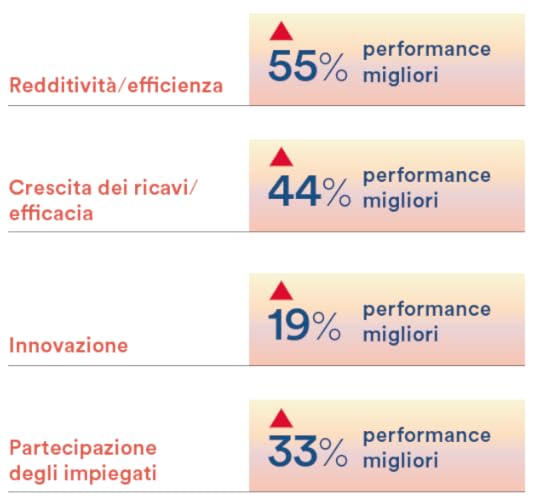
Se le aziende vogliono crescere e competere in un mondo sempre più repentinamente tendente all’IA, dovranno abbracciare una strategia combinata, composta da automazione e potenziamento. Le aziende dovranno, insomma, sviluppare un quadro di “job to be done” in grado di rispecchiare le nuove potenzialità e aspettative introdotte dall’IA generativa.
Riorientamento sulla scorta dei “job to be done”
Nel pianificare le prossime fasi relative all’IA, è necessario iniziare considerando i “job to be done” l’unità di riferimento per l’analisi. Successivamente si passa alla definizione di come sarà il futuro stato motivante dell’iterazione in combinazione con l’innovazione.
1. Identificare i lavori interessati dall’IA: identificare i lavori che clienti e dipendenti stanno cercando di portare a termine e il modo in cui l’IA sta cambiando i comportamenti e le misure o ne introduce di nuovi. Effettuare una segmentazione per lavoro.
2. Comprendere il contesto influenzato dall’IA: studiare l’evoluzione del lavoro e come l’IA stia potenziando o cambiando il modo in cui clienti e dipendenti organizzano la propria attività. Prestare attenzione a eventuali punti dolenti, trade-off e attriti. Prestare attenzione agli spunti e fornire suggerimenti per evoluzione ingegneristica, risoluzioni e violazioni. Questi elementi rappresentano indizi incredibili per l’innovazione e la creazione di valore.
3. Identificare i criteri di successo in ambiente IA: sono i criteri che clienti e dipendenti impiegano per giudicare il proprio successo nel portare a termine il lavoro. Possono comprendere velocità, intuizione e facilità d’uso, creazione di nuovo valore, esperienza globale, raggiungimento degli obiettivi e altri fattori. 4. Dare la priorità e segmentare i “job to be done” guidati dall’IA: organizzare i “job to be done” come oggetto di automazione e potenziamento. Per una categorizzazione efficace, rilevare il livello di soddisfazione di dipendenti e clienti rispetto al servizio o alla soluzione esistenti. In questo modo sarà possibile definire quelli potenzialmente più efficienti o efficaci.
5. Ideare una proposta di valore incentrata sull’IA: sviluppare una narrazione che dia testimonianza del rapporto simbiotico tra l’IA e l’uomo. Proporre la prospettiva del cliente o del dipendente, sottolineando non solo efficienza ed eliminazione dei costi, ma anche come l’IA migliori la creatività umana, il processo decisionale e i risultati. Utilizzare uno storytelling che metta in risalto i casi di utilizzo alternativo e trasformativo.
6. Innovare per definire i flussi di lavoro migliorati dall’IA: fare leva sull’IA nell’ambito del processo di innovazione per sviluppare nuovi flussi di lavoro soddisfacenti, efficienti ed efficaci, in grado di introdurre modalità ancora migliori per realizzare e sperimentare i “job to be done”.
7. Pubblicizzare il lavoro potenziato dall’IA: mettere in evidenza i benefici a breve e lungo termine che l’IA può garantire sul lavoro, oltre al valore e ai vantaggi derivanti dalla collaborazione tra uomo e IA.
8. Iterare, evolvere e innovare con l’IA: con la maturazione dell’IA e l’introduzione di nuove soluzioni di IA, rivalutare i “job to be done” per restare al passo ed essere innovativi. Creare un circuito di feedback per analizzare e ottimizzare i flussi di lavoro. Inserire attività previsionali e pianificazione degli scenari per i futuri cambiamenti guidati dall’IA. Servirsi dell’analisi dei dati e dell’IA generativa per prevedere tendenze e comportamenti emergenti.
Nel suo nuovo lavoro L’Atto Creativo, il leggendario produttore musicale Rick Rubin ha scritto: “Diffidate dell’assunto secondo cui il modo in cui lavorate è il migliore solo perché è quello che avete sempre seguito in passato”.
L’IA generativa ha finalmente creato una spaccatura rispetto all’approccio “business as usual”.
Comprendere e innovare a fronte dei “job to be done” consente non solo di essere reattivi alle novità introdotte dall’IA, ma anche di anticipare le attività future e le modalità con cui i “job to be done” continueranno a evolvere e a modificarsi. In un mondo che mette l’IA in primo piano, l’unico “business as usual” sarà quello definito da resilienza e innovazione.
The post Harvard Business Review Italia: Innovare con l’IA: una sfida all’approccio “business as usual” appeared first on Brian Solis.
March 17, 2025
NACD: In an Era of AI, Boards Must Disrupt Legacy Leadership by Brian Solis

NACD is the most trusted association for board directors. The association’s official publication, Directorship Magazine, featured a contributed article by Brian Solis, “In an Era of AI, Boards Must Disrupt Legacy Leadership.”
CEOs have leaned into generative artificial intelligence (genAI) like no other technology in history. According to Fortune, there were more than 30,000 mentions of AI on earnings calls by the end of 2023.
Yet, the Economist reported that, so far, genAI has had almost no economic impact. This could be why research shows that 66 percent of leaders are “ambivalent or outright dissatisfied” with their companies’ AI and genAI progress thus far. No matter the challenge, businesses cannot afford to sit on the sidelines. As a result, CEOs and boards should partner to balance risks and opportunities, with boards leaning in to ensure that management is adequately prepared and supported to integrate genAI into operations and overall business transformation initiatives.
The Economist suggested that for AI to fulfill its potential, organizations will need to accelerate adoption, drive automation beyond niche applications, and scale productivity. Certainly, there are reasons why companies are slow to adopt AI. Data security, potentially biased algorithms, and hallucinations are impeding the rollout. At the same time, a new mind-set shift is needed to see AI in a different light.
Adopt an Innovation Mind-Set, Beyond Iteration
Previously, when I prepared for board meetings, I usually found myself catering to the board’s expectations and language. I made sure to structure my work against the board’s priorities. At some point along the way, although I was meeting the board’s objectives, I realized I wasn’t truly helping directors help the company or its long-term viability.
Leaders who hear what they need to hear will eventually be surrounded by people who have nothing meaningful to say. True leaders listen to the truth. The world needs more tellers. And the truth is that AI presents an incredible shift that most leaders are not, but think they are, prepared for.
Venture capitalist Vinod Khosla recently observed in an X (formerly known as Twitter) post, “Most businesses have no clue what is about to hit them in the next 10 years when most rules of engagement will change.”
Here, Khosla highlights the profound and transformative impact that AI will have on the business landscape. He believes that AI will disrupt almost every industry and change the fundamental ways in which companies operate, compete, and engage with employees and customers.
What is it that Khosla is warning leaders about? AI technologies are evolving at an unprecedented pace. Many organizations, especially those reliant on traditional methods of doing business, are unprepared for the speed and scale at which AI could disrupt their industries. What seems to be gradual technological progress today could result in sweeping changes in just a few years.
AI will shift the competitive landscape. Leaders that harness AI effectively will have significant advantages in terms of efficiency, customer insights, innovation, and product development.
It is already automating many routine tasks. Over a short amount of time, automation will dramatically alter the workforce. It’s up to leaders to determine whether that’s a boon or a threat to their organizations. Leaders that don’t anticipate these changes may struggle with workforce transitions and operational disruptions.
The technology could make many existing business models unsustainable and, worse, obsolete. For example, industries such as finance, health care, retail, and manufacturing will see profound shifts in how they operate, serve customers, and generate revenue. AI is expected to create entirely new categories of products and services. Companies that don’t innovate or experiment with AI to create these new offerings will risk being left behind.
These are just some of the ways that the rules of engagement will shift. Added up, this could lead to the rise of new market leaders and the decline of incumbents that fail to adapt. If there were ever a time to innovate the role of boards and their impact on the organizations they advise, it is now.
Boards Cannot Afford to Fall into the Innovation Trap
Historically, every technological revolution has been folded into legacy systems and processes, all for good reasons. If business as usual is still working, why rock the boat? The same is true for AI. If companies can further optimize existing work and processes while driving efficiencies, productivity, and scale, as well as lowering costs along the way, what’s the problem? After all, established processes, workflows, and culture often favor incremental improvements over radical change—until they don’t.
This exemplifies an iterative mind-set, and it is often mistaken for one of innovation. This is the innovation trap. Iteration works until the need for innovation becomes the only way forward. The trick is that iteration can look a lot like innovation to those who don’t understand the difference between incrementalism and transformation.
It is easy to fall into the innovation trap. With every new technology revolution, investments masquerade as innovation because they are new to the organization, requiring new strategies, skills, and resources to support them. The catch is, if a company uses new technologies to improve what it did yesterday, it is iterating and not innovating. While iteration is important, if a company is not innovating, it isn’t future-proofing itself.
For boards, the innovation trap becomes harder to see, because, in the short-term, the spoils of incrementalism are wrapped in cost savings, profitability, and shareholder returns. Without innovation, however, the once-vibrant streams produced by iteration eventually thin and run out. This is when a pivot becomes reactive rather than proactive, delivering a costly if not fatal blow to the organization.
Iteration Versus Innovation
The dichotomy with innovation is that it can eventually replenish and grow shareholder value, but the strategy to get there is not guaranteed and comes with costs, risks, and uncertainty. But if leaders routinely explore how to align new technologies, beyond iteration, to unlock net new value creation and do something that the company didn’t or couldn’t do yesterday, it potentially augments the company’s future trajectory. This would be iterating and innovating. Organizations need to practice the discipline of both; CEOs need the runway to do so and boards should become the air traffic controllers to guide and protect them.
There are many cases where business as usual does not survive disruption. AI is yet the next disruptor, a harbinger of innovation. But this time, the innovation is exponential.
Scaling new technologies through iterative investments can effectively create a linear path of growth. Think about the most-cited genAI benefits today: time saved, reduced costs, optimized self-service for customers and employees. GenAI is quickly delivering incremental benefits while becoming the status quo. Empowered, creative, and bold leaders are also asking, What can be done with time saved? What else could high-performing teams do while automation tackles repetitive tasks?
An example of how AI can cut costs and drive growth is IKEA’s Billie, an AI chatbot designed to handle first-level customer interactions. After launching in 2023, Billie managed 47 percent of the queries that were typically routed to IKEA’s call centers, successfully resolving 3.2 million interactions and delivering an impressive €13 million in savings. At a time when many executives are looking to AI for cost-cutting, particularly through workforce reduction, IKEA chose an augmented path. Rather than downsizing, the company reskilled 8,500 call center employees, empowering them to transition into roles that required human expertise, such as remote interior design consulting and digital retail sales, to help build deeper customer relationships and solve complex problems. This shift not only safeguarded jobs but also led to €1.3 billion in sales through these enhanced customer experiences and contributed to nearly 4 percent of IKEA’s total sales in its first year of use. This type of transformative vision can redefine an organization’s future by blending automation with human intelligence to drive both efficiency and growth.
These outcomes demonstrate the valuable relationship between iteration and innovation. Combined, they can yield linear and exponential performance and returns.
Disrupt or Be Disrupted
How can boards advocate for long-term AI innovation when most organizations operate against short-term, quarter-to-quarter strategies and measures? Start with a mind-set shift.
Working with C-suites to evaluate the potential and risks of AI and to establish centers of excellence is important, but these are not long-term solutions to viability. Boards should advocate for cultures of AI-powered innovation.
They can do this by empowering executives to challenge fundamental assumptions about business and operational models. Executives should be given the room to explore new horizons for innovation and transformation while also iterating linear growth.
Boards can collaborate with C-suites to iterate and innovate toward a more rewarding and promising future by considering the following actions:
Align AI initiatives with short- to long-term strategic objectives.Develop a long-term AI-powered innovation road map that outlines key milestones and timelines for achieving long-term AI innovation objectives.Allocate resources strategically. Dedicate a specific percentage of resources to long-term AI innovation projects while maintaining focus on short-term operational needs.Foster an organizational culture that values long-term thinking and innovation.Adopt a balanced scorecard approach that includes both short-term operational metrics and long-term strategic indicators related to AI innovation.Educate fellow board members and executives to ensure that they understand the long-term potential and implications of AI technologies.Partner with academic institutions to access cutting-edge research and expertise, which can provide a competitive edge in long-term AI innovation.Communicate the short- and long-term AI vision, including the path to get there, to stakeholders and investors to manage expectations and justify investments in innovation.Monitor and adapt to market changes and adjust long-term AI strategies in response to significant market shifts without losing focus on the need to continuously innovate.Highlight successful AI implementations and their impact on the business to demonstrate the value of sustained innovation efforts.A mind-set shift among board members and C-suites is critical today. Businesses that fail to adopt these innovations could lose their competitive edge.
The post NACD: In an Era of AI, Boards Must Disrupt Legacy Leadership by Brian Solis appeared first on Brian Solis.
March 14, 2025
Integrated Systems Europe: Embracing AI Without Fear – A Summary of the Opening Keynote by Brian Solis
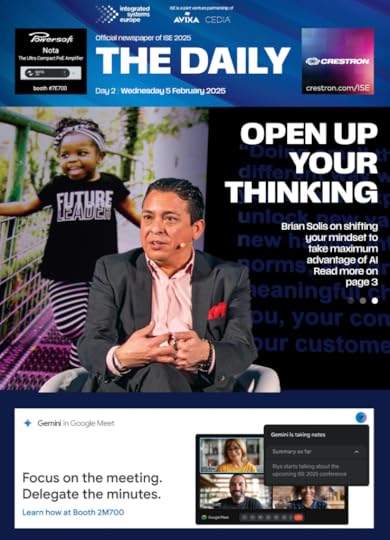
The opening keynote at ISE 2025 by Brian Solis was featured in the Integrated Systems Europe Daily along with the panel he participated in following his talk.
To banish anxiety from a future completely reshaped by AI, it’s important to create new relevance rather than extending yesterday’s, according to digital analyst, author and visionary Brian Solis. He urged people to allow themselves to be disrupted, and to look at AI not with the limitations of an expert, but with the eyes of a child open to all possibilities.
As part of his ISE 2025 OpeningKeynote speech yesterday, Solis suggested setting up a daily exploratory prompting practice to rewire the brain to collaborate with AI, rather than fight against it. “We need a mindset shift to be able to see the future differently, to take AI and let it inspire us to actually think outside of the box and explore the world of the unknown.”
“Where AI becomes magical is when you expect the unexpected, where you don’t know what’s on the other side of the prompt, and you keep prompting it until you come up with something that is just incredible.”
Those waiting for someone to tell them what to do with AI are on the wrong side of innovation, he warned. With its
consumerisation, AI is the first technology that cannot be put in a “business as usual” box.
“What makes this moment so special is that there’s no playbook for how to integrate AI in our work. You get to imagine what the future looks like,” said Solis.
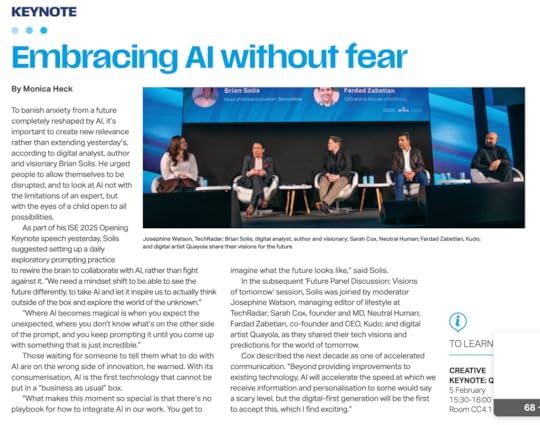
In the subsequent ‘Future Panel Discussion: Visions of tomorrow’ session, Solis was joined by moderator Josephine Watson, managing editor of lifestyle at TechRadar; Sarah Cox, founder and MD, Neutral Human; Fardad Zabetian, co-founder and CEO, Kudo; and digital artist Quayola, as they shared their tech visions and predictions for the world of tomorrow.
Cox described the next decade as one of accelerated communication. “Beyond providing improvements to existing technology, AI will accelerate the speed at which we receive information and personalisation to some would say
a scary level, but the digital-first generation will be the first to accept this, which I find exciting.”
The post Integrated Systems Europe: Embracing AI Without Fear – A Summary of the Opening Keynote by Brian Solis appeared first on Brian Solis.
March 12, 2025
4 skills for guiding AI transformation

Portland, OR, USA – Sep 1, 2024: ChatGPT, Gemini, Microsoft Copilot, Claude, and Perplexity app icons are seen on a Google Pixel smartphone. AI competition concepts. Source: Ragan
Brian Solis was interviewed by Brian Pittman ahead of his keynote presentation at the AI Horizons Conference in Miami.
Want to shape your org’s AI strategy? Here are 4 skills for guiding AI transformation and how to lead with both innovation and humanity.
The AI gold rush in on — but are organizations asking the right questions?
According to Brian Solis, head of global innovation at ServiceNow and author of “Mindshift,” the real threat isn’t the technology but how organizations implement it.
“The greatest challenge communicators face is losing humanity in the pursuit of efficiency,” he says. “AI can automate workflows and generate content — but it can’t replace empathy, creativity or relevance.”
For communicators, this is the moment to step up and help guide organizations through this transformation. Here’s how:
Prioritize augmentation over automation. “AI should be a tool for enhancement, not a crutch,” says Solis. “Focus on how AI can bring you closer to your audience rather than automating parts of your job.”He suggests pausing each time you open an AI chat window: “Ask yourself if what you’re doing will truly enhance connection. If the answer is no, you risk diluting meaning.”
AI is invaluable for handling repetitive tasks like data analysis or content repurposing. “But you should really invest your time in collaborating with trained models that can help shape and augment messages that spark emotion, inspire trust and foster deeper relationships,” says Solis.
Develop soft skills alongside AI fluency. Technical AI know-how is crucial. “But soft skills like empathy, ethics and creativity require just as much intentional practice,” he says.Here’s how to hone both:
Practice empathetic listening. Before responding, whether online, with AI or in person, ask yourself, “What truly matters here? What would I need to hear to be inspired to change?” This validates others’ perspectives while also forcing you to slow down and consider alternate views.Sharpen self-awareness. Mindfulness and seeking feedback can help, but Solis urges communicators to dig deeper: “Do the hard work of understanding your own biases, questioning assumptions and aligning messages with values that truly resonate.”Keep a “mindshift” journal. While a traditional journaling practice can help improve empathy and self-awareness, Solis advises keeping a “mindshift” journal.“Document your communication wins and misses — focusing on emotional impact rather than just metrics,” he says. “Ask yourself what messages resonated, which fell flat — and why.”
By focusing on real reactions, and not just click or open rates, you can begin to see patterns in how people emotionally respond to your messages so you can build deeper connections. This helps refine your storytelling over time, ensuring your message align with audience needs.
Make storytelling your superpower. “AI is a remarkable enabler, but when automation takes the lead over imagination, mediocrity follows,” Solis warns. “Human-centered innovation is about balancing AI’s capabilities with human ingenuity. It’s about using AI to spark creativity — not dictate it.”The key is transforming information into inspiration through storytelling. “While AI can generate coherent narratives, it lacks lived experiences and the ability to tap into the nuances of human struggle and triumph,” Solis says. “That’s where you come in.”
Here are two quick tips to harness both imagination and storytelling:
Use storyboarding as a thinking tool. Solis credits Nick Sung (Pixar, Netflix) for teaching him that storytelling isn’t just about words — it’s about designing anexperience.Storyboarding is a great way to get started, he suggests. “Map out emotional highs and lows before writing. Ask yourself, ‘Where does the audience feel tension? Relief? Inspiration to act?’”
By breaking your message into visual and emotional beats, you can ensure every moment earns attention, builds curiosity and delivers impact, which are essential in a world flooded with AI-generated content that often feels formulaic and forgettable. “Think scenes, not slides,” advises Solis.
Frame every communication as a hero’s journey. “Instead of listing facts or promoting features, tell a story with a beginning (a problem your audience relates to), a middle (the transformation or insight) and an end (a resolution that inspires action),” says Solis.Lead the AI transformation responsibly. “Too often, AI adoption is treated as a top-down directive, leaving communicators in a reactive role,” says Solis. “But those who lean into AI early — experimenting with its potential and guiding its ethical implementation — will shape the future of corporate messaging.”The opportunity is significant: AI enables hyper-personalized messaging at scale, but the risk is losing trust. “As AI deepfakes and content proliferate, audiences will become more skeptical,” he warns.
Here’s how to lead effectively while avoiding the pitfalls:
Adopt a trust-first approach. “Always disclose when AI is involved in content creation and ensure there’s human review in the process,” says Solis. “Focus on building relationships, not just delivering messages. In the AI era, trust will be the most valuable currency — so protect it fiercely.”Position yourself as an AI translator.A core element of this strategy is developing ethical AI guidelines to ensure transparency, authenticity and alignment with your organization’s values.
“Don’t let those conversations happen without you,” he warns. “When you take charge of the AI narrative, you move from being a messenger to being a strategist.”
Leverage AI as a catalyst, not a crutch.“The future belongs to those who combine AI-driven intelligence with human-centered insight, he concludes. “The question isn’t whether AI will shape communication. It’s whether we’ll use it to enhance our humanity or diminish it. Choose wisely.”
Please read the full article here.
The post 4 skills for guiding AI transformation appeared first on Brian Solis.
March 11, 2025
Brian Solis to Keynote Avasant’s Empowering Beyond Summit
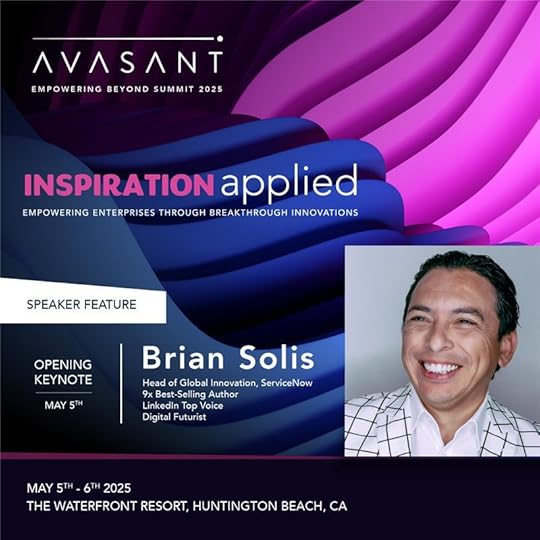
Inspiration Applied: The Vision You Need for What’s Next
At Avasant’s Empowering Beyond Summit 2025, Brian Solis a globally recognized futurist and one of the most influential voices in business transformation, will take the stage to share his ground-breaking insights on the next era of enterprise evolution.
Hailed as “one of the greatest digital analysts of our time” and a “must-follow thought leader in Generative AI,” Brian decodes the intersection of AI, innovation, and digital transformation—helping leaders navigate disruption and drive meaningful change.
Join us at EBS25 on May 5th and 6th to hear Brian’s bold and unique perspectives on what’s coming next – and how to thrive in the future of business.
Register Now and Access Early Bird Tickets Until February 15th: https://hubs.ly/Q036F9810
This is a keynote you won’t want to miss!
The post Brian Solis to Keynote Avasant’s Empowering Beyond Summit appeared first on Brian Solis.
An Interview With Brian Solis. What if Your Digital Transformation Was as Easy as Changing Your Mind

What if Digital Transformation was as easy as changing your mind? Therein lies the challenge. Changing your mind isn’t easy. 
I joined Jim Hertzfeld on “What If? So What?” to unpack the power of a #Mindshift. 
We explore how storytelling can inspire creativity and imagination and help leaders envision a better future for their organizations. 
We also highlight the impact of Generative AI on business transformation and the need for leaders to embrace new technologies to stay ahead the curve. 

The post An Interview With Brian Solis. What if Your Digital Transformation Was as Easy as Changing Your Mind appeared first on Brian Solis.



